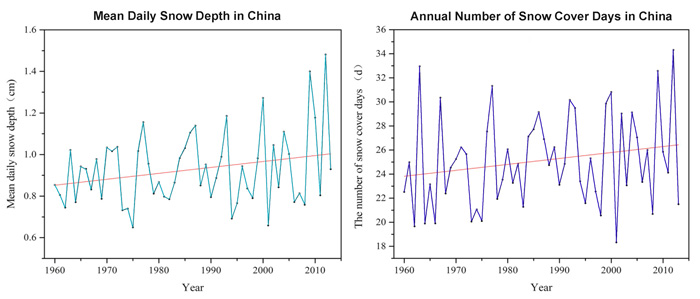| Tweet | Follow @co2science |
Paper Reviewed
Xuejin, T., Zhenni, W., Xingmin, M., Peng, G., Guangju, Z., Wenyi, S. and Chaojun, G. 2019. Spatiotemporal changes in snow cover over China during 1960-2013. Atmospheric Research 218: 183-194.
Climate alarmists have claimed that global warming will reduce both the frequency and magnitude of snowfall, in some places eliminating precipitation in the form of snow altogether. Hence, it is only logical to examine the verity of such claims against the historical record to learn if snowfall is indeed on the decline as temperatures have warmed.
Thanks to the recent work of Xuejin et al. (2019), the global warming-induced snowfall decline hypothesis has now been tested for all of China. Working with daily snowfall data from 201 locations spread across China, the seven Chinese scientists calculated and analyzed trends in snow depth and the number of snow-cover days over the period 1960-2013, during which time they say spring and winter temperatures increased approximately 0.24 °C to 0.44 °C per decade. And what did their analysis reveal?
Although the trends in snow depth and the number of snow-cover days varied among the individual stations, averaged for all of China both parameters increased (see Figure 1 below). More specifically, over the 54-year period mean annual daily snow depth increased by 0.028 cm per decade (p = 0.06) and mean annual snow-cover days rose by 0.49 day per decade (p = 0.14). Xuejin et al. additionally report that no correlation was identified between temperature and either of the two snow-related parameters and that "the spatial variability of mean daily snow depth and the number of snow cover days in China did not change statistically significantly under the background of global warming."
In considering the findings presented above, the climate alarmist hypothesis of a warming-induced decline in snowfall is invalidated, at least for China in terms of snow depth and snow cover. Hence, it would appear that another of their predictions has melted away, unable to withstand the heat of the observational record.

Figure 1. Variations of mean daily snow depth and the number of snow-cover days in China over the period 1960-2013. Source: Xuejin et al. (2019).




